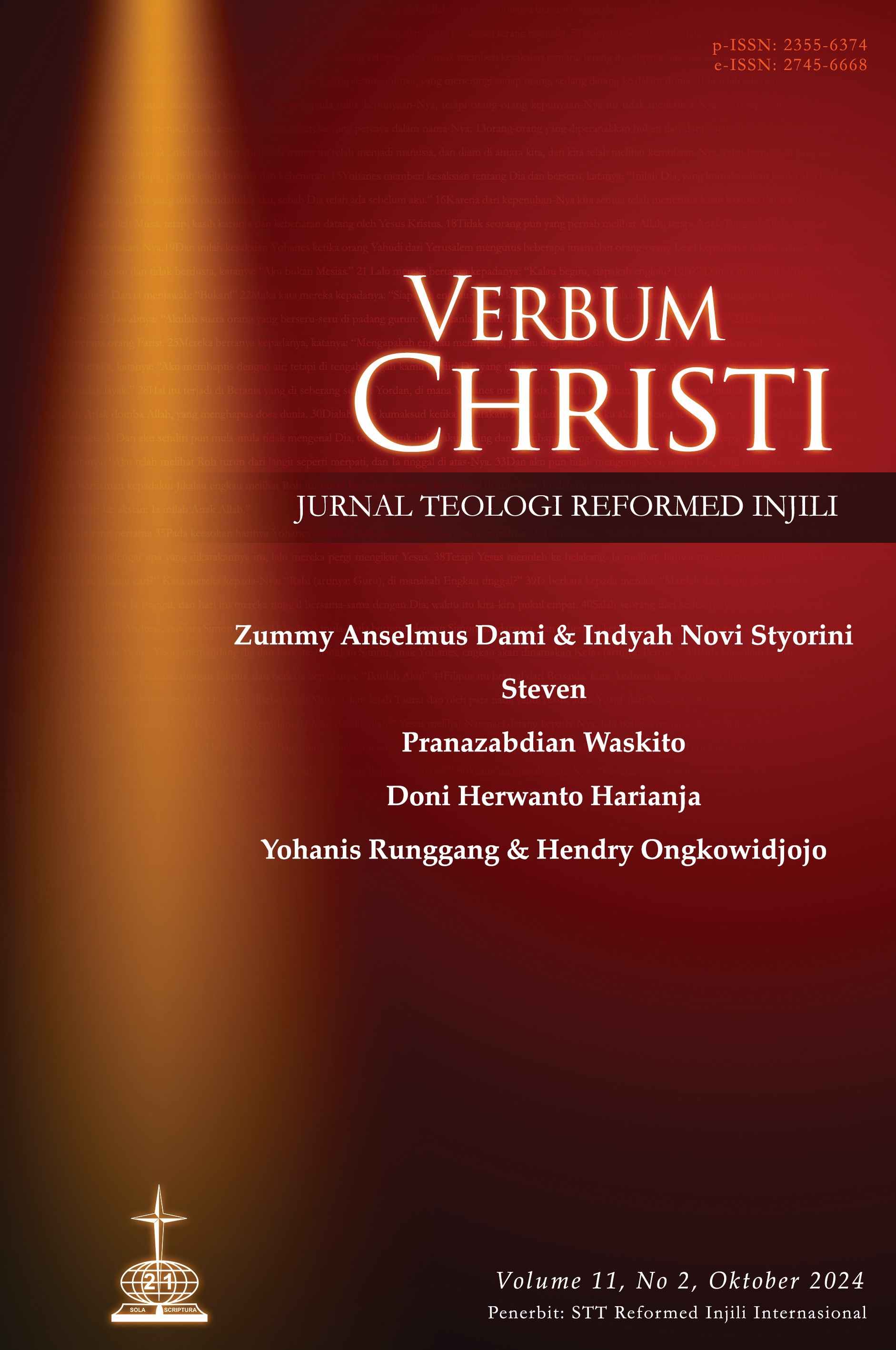Teknik Penerjemahan Kejadian 1-2 dalam Alkitab Terjemahan Baru Indonesia Edisi Kedua
DOI:
https://doi.org/10.51688/VC11.2.2024.art2Kata Kunci:
Terjemahan Baru 2, Kejadian 1-2, kritik teksAbstrak
Penerjemahan Alkitab Perjanjian Lama dari bahasa Ibrani-Aram ke bahasa lain selalu menimbulkan persoalan tekstual. Permasalahannya, dalam konteks Alkitab bahasa Indonesia, persoalan tersebut belum mendapat perhatian yang cukup dan akademis. Dengan terbitnya Alkitab Terjemahan Baru edisi kedua pada tahun 2023, tulisan ini akan meninjau teknik penerjemahan TB2 dari sampel Kejadian 1-2 menggunakan metode kritik teks. Teks Terjemahan Baru edisi pertama (TB) akan dibandingkan juga bersama dengan teks Masoret (MT), serta Septuaginta (LXX). Hasilnya, (1) penerjemahan TB2 menunjukkan kesinambungan padanan kata dengan MT, (2) TB2 menerjemahkan MT secara literal, dan (3) sejauh ayat tidak bermasalah, TB2 lebih mencerminkan MT sebagai Vorlage. Dengan demikian, artikel ini diharapkan dapat menyumbang masukan terhadap teknik penerjemahan Alkitab ke dalam bahasa Indonesia di masa yang akan datang.
Unduhan
Referensi
Alter, Robert. The Art of Biblical Narrative. New York: Basic Books, 1981.
Alwi, Hasan, Anton Moeliono, Hans Lapoliwa, Sry Satya Tjatur Wisnu Sasangka, dan Sugiyono. Tata Bahasa Baku Bahasa Indonesia. Jakarta: Balai Pustaka, 2010.
Badan Pengembangan dan Pembinaan Bahasa. “Diksi.” KBBI VI Daring (blog), 2016. https://kbbi.kemdikbud.go.id/entri/diksi.
Batto, Bernard F. In the Beginning: Essays on Creation Motifs in the Ancient Near East and the Bible. Indiana: Eisenbrauns, 2013.
Botterweck, G. Johannes, Helmer Ringgren, dan Heinz-Josef Fabry, ed. “פנים.” Dalam Theological Dictionary of the Old Testament. Vol. XI. Grand Rapids: William B. Eerdmans, 1997.
Brayford, Susan. Genesis. Septuagint Commentary Series. Leiden: Brill, 2007.
Chaer, Abdul. Pengantar Semantik Bahasa Indonesia. Jakarta: PT Rineka Cipta, 2013.
Dendi, Sugono, ed. Buku Praktis Bahasa Indonesia. Jakarta: Pusat Bahasa, 2005.
Evans, Trevor V. “The Nature of Septuagint Greek: Language and Lexicography.” Dalam The Oxford Handbook of the Septuagint, disunting oleh Alison G. Salvesen dan Timothy Michael Law, 91–104. Oxford: Oxford University Press, 2021.
Gesenius, Wilhelm. Hebräisches und Chaldäisches Handwörterbuch über das Alte Testament. Leipzig: Verlag von F. C. W. Vogel, 1878.
Johnson, Benjamin J. M. “Reconsidering 4QSama and the Textual Support for the Long and Short Versions of the David and Goliath Story,” Vetus Testamentum, 62 (2012): 534–49.
Joosten, Jan. “The Interplay between Hebrew and Greek in Biblical Lexicology: Language, Text, and Interpretation.” Dalam Biblical Lexicology: Hebrew and Greek: Semantic-Exegesis-Translation, disunting oleh Eberhard Bons, Jan Joosten, dan Regine Hunziker-Rodewald, 209–26. Beihefte zur Zeitschrift für die alttestamentliche Wissenschaft. Berlin/Boston: Walter de Gruyter, 2015.
———. “Wilhelm Genesius and the History of Hebrew in the Biblical Period.” Dalam Biblische Exegese und hebräische Lexikographie: Das „Hebräisch-deutsche Handwörterbuch“ von Wilhelm Gesenius als Spiegel und Quelle alttestamentlicher und hebräischer Forschung, 200 Jahre nach seiner ersten Auflage, disunting oleh Stefan Schorch, 94–106. Beihefte zur Zeitschrift für die alttestamentliche Wissenschaft 427. Berlin/Boston: De Gruyter, 2013.
Kelley, Page H. Biblical Hebrew: An Introductory Grammar. Grand Rapids: William B. Eerdmans, 1992.
Kikawada, Isaac M. “The Double Creation of Mankind in Enki and Ninmah, Atrahasis I 1-351, and Genesis 1-2.” British School of Archeology in Iraq, Iraq, 45 (1983): 43–45.
Liddell, Henry George, dan Robert Scott. “επανω.” Dalam A Greek-English Lexicon. Oxford: Clarendon Press, 1961.
Lust, Johan. “The Story of David and Goliath in Hebrew and in Greek.” Dalam The Story of David and Goliath: Textual and Literary Criticism, 5–14. Orbis Biblicus Et Orientalis 73. Göttingen: Vandenhoeck & Ruprecht, 1986.
Merwe, Christo H. J. van der, Jacobus A. Naudé, dan Jan H. Kroeze. A Biblical Hebrew Reference Grammar. Sheffield: Sheffield Academic Press, 1999.
Payne, David F. “Old Testament Textual Criticism - Its Principles and Practice: Apropos of Recent English Versions.” Tyndale Bulletin 25, no. 1 (1974): 99–112. https://doi.org/10.53751/001c.30638.
Penjelasan Singkat Alkitab Terjemahan Baru Edisi Kedua (TB2). Jakarta: Lembaga Alkitab Indonesia, 2023.
Rahlfs, Alfred. Septuaginta. Stuttgart: Deutsche Bibelgesellschaft, 1979.
Tal, Abraham. Genesis. Vol. 1. Biblia Hebraica Quinta. Stuttgart: Deutsche Bibelgesellschaft, 2015.
Tov, Emanuel. Textual Criticism of the Hebrew Bible. Minneapolis: Fortress Press, 2012.
———. “The Essence and History of the Masoretic Text,” Bogoslovlje: Journal of the Faculty of Orthodox Theology, 1, no. 1 (2017): 7–26.
———. “The LXX Translators’ Procedures in Representing Proper Names: Consistency in Representation.” Dalam Studies in Textual Criticism, 5:319–39. VTSup 197. Leiden: Brill, 2024.
———. “The Story of David and Goliath in the MT and LXX.” Dalam The Story of David and Goliath: Textual and Literary Criticism, 39–43. Orbis Biblicus Et Orientalis 73. Göttingen: Vandenhoeck & Ruprecht, 1986.
———. The Text-Critical Use of the Septuagint in Biblical Research. 3 ed. Winona Lake, Indiana: Eisenbrauns, 2015.
Tsedaka, Benyamim, ed. The Israelite Samaritan Version of the Torah: First English Translation Compared with the Masoretic Version. Diterjemahkan oleh Benyamim Tsedaka. Grand Rapids: William B. Eerdmans, 2013.
Warsiman. Bahasa Indonesia Ilmiah untuk Penulisan Laporan, Skripsi, Tesis, dan Disertasi. Malang: UB Press, 2013.
Webster, Brian L. The Cambridge Introduction to Biblical Hebrew. Cambridge: Cambridge University Press, 2009.
Weisberg, David B. “Break in the Middle of a Verse: Some Observations on a Masoretic Feature.” Dalam Leaders and Legacies in Assyriology and Bible: The Collected Essays of David B. Weisberg. Indiana: Eisenbrauns, 2012.
Würthwein, Ernst. The Text of the Old Testament: An Introduction to the Biblica Hebraica. Diterjemahkan oleh Erroll F. Rhodes. Grand Rapids: Eerdmans, 1995.
Unduhan
Diterbitkan
Cara Mengutip
Terbitan
Bagian
Lisensi
Artikel ini mengikuti ketentuan Creative Commons Attribution-NonCommercial 4.0 International License.
Hak Cipta (c) 2024 Verbum Christi: Jurnal Teologi Reformed Injili. Hak tersebut dipegang jurnal dengan sepengetahuan penulis.




